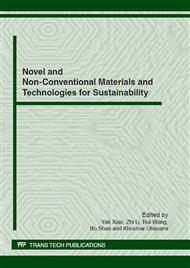p.437
p.450
p.458
p.469
p.477
p.487
p.495
p.500
p.506
Solubility of Silicate from Sugar Cane Bagasse Ash in Alkaline Solution
Abstract:
Sugar cane bagasse ash (SCBA) is a byproduct rich in silica, which it is present as of both crystalline and amorphous phases. This paper aims to evaluate the effect of grain size of residual SCBA particles on the solubility of silicate species in alkaline solutions that still needs examination. The influence of the amorphous character of the material was also investigated. Physical characterization was performed by the assessment of density and specific area of powder samples. Chemical and mineralogical characterizations were performed using different techniques including x-ray fluorescence, x-ray diffraction, infrared spectroscopy and scanning electron microscopy. The results indicate that the grinding process reduces the specific area of the particles of ash in a non linear fashion. The controlled burning of sugar cane bagasse increased the amorphous character of the ash. Nonetheless both factors affected the solubility of silicates, the degree of crystalinity appears to be the most important factor.
Info:
Periodical:
Pages:
477-483
Citation:
Online since:
June 2012
Keywords:
Price:
Сopyright:
© 2012 Trans Tech Publications Ltd. All Rights Reserved
Share:
Citation:


